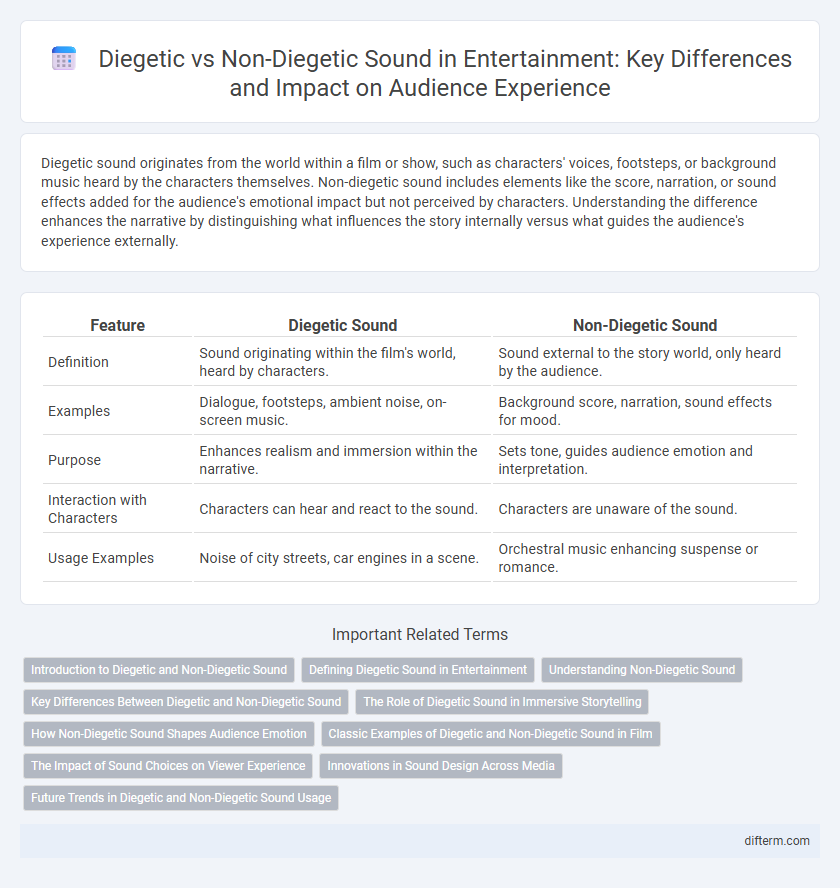Diegetic sound originates from the world within a film or show, such as characters' voices, footsteps, or background music heard by the characters themselves. Non-diegetic sound includes elements like the score, narration, or sound effects added for the audience's emotional impact but not perceived by characters. Understanding the difference enhances the narrative by distinguishing what influences the story internally versus what guides the audience's experience externally.
Table of Comparison
| Feature | Diegetic Sound | Non-Diegetic Sound |
|---|---|---|
| Definition | Sound originating within the film's world, heard by characters. | Sound external to the story world, only heard by the audience. |
| Examples | Dialogue, footsteps, ambient noise, on-screen music. | Background score, narration, sound effects for mood. |
| Purpose | Enhances realism and immersion within the narrative. | Sets tone, guides audience emotion and interpretation. |
| Interaction with Characters | Characters can hear and react to the sound. | Characters are unaware of the sound. |
| Usage Examples | Noise of city streets, car engines in a scene. | Orchestral music enhancing suspense or romance. |
Introduction to Diegetic and Non-Diegetic Sound
Diegetic sound originates from sources within the film's world, such as character dialogue, footsteps, or ambient noises, enhancing realism and audience immersion. Non-diegetic sound includes elements like background music, voice-over narration, and sound effects not heard by characters, used to influence mood and guide emotional responses. Understanding the distinction between diegetic and non-diegetic sound is fundamental in film studies and sound design, as it shapes narrative perception and viewer engagement.
Defining Diegetic Sound in Entertainment
Diegetic sound in entertainment refers to audio elements originating within the narrative world that characters can hear, such as dialogue, footsteps, or ambient noises. This type of sound enhances storytelling by grounding the audience in the scene's environment and providing realism. Understanding diegetic sound is crucial for filmmakers to create immersive and believable experiences.
Understanding Non-Diegetic Sound
Non-diegetic sound refers to audio elements in a film or show that do not originate from the story world, such as background music, voice-over narration, or sound effects added for dramatic impact. These sounds enhance the emotional experience and guide the audience's interpretation without being heard by the characters. Understanding non-diegetic sound is essential for analyzing cinematic techniques and the overall storytelling structure in entertainment media.
Key Differences Between Diegetic and Non-Diegetic Sound
Diegetic sound originates from sources within the film's world, such as characters' voices, footsteps, or environmental noises, making it part of the narrative reality. Non-diegetic sound includes elements like background music, narration, or sound effects added for dramatic effect that the characters do not hear. The key difference lies in whether the sound exists within the story's universe (diegetic) or is external, enhancing viewer experience without being acknowledged by characters (non-diegetic).
The Role of Diegetic Sound in Immersive Storytelling
Diegetic sound, originating from sources within the film's world, enhances immersive storytelling by grounding viewers in the narrative reality and deepening emotional engagement. Sounds like character dialogue, footsteps, and environmental noises create a sensory experience that aligns audience perception with on-screen events. This auditory realism contrasts with non-diegetic sound, which manipulates mood without existing in the story space, making diegetic elements crucial for authentic narrative immersion.
How Non-Diegetic Sound Shapes Audience Emotion
Non-diegetic sound, such as a film's musical score or voice-over narration, plays a crucial role in shaping audience emotion by enhancing mood and heightening tension beyond the on-screen action. This type of sound operates independently from the diegetic world, guiding viewers' emotional responses through cues like suspenseful music in thrillers or uplifting themes in dramas. By manipulating tone and rhythm, non-diegetic sound deepens immersion and influences psychological engagement without altering the narrative's reality.
Classic Examples of Diegetic and Non-Diegetic Sound in Film
Classic examples of diegetic sound in film include footsteps, dialogue, and ambient noises like rain or a ticking clock heard by characters in the scene. Non-diegetic sound typically features background scores, narration, or sound effects added for dramatic effect, such as the iconic suspense music in Hitchcock's Psycho. Alfred Hitchcock's use of diegetic and non-diegetic sounds in Psycho and the Transformers franchise's blend of engine roars (diegetic) with orchestral music (non-diegetic) illustrate the powerful impact of sound layering in storytelling.
The Impact of Sound Choices on Viewer Experience
Diegetic sound, originating from sources visible or implied within the film's world, grounds the viewer in the narrative by enhancing realism and immersion. Non-diegetic sound, such as the musical score or voiceovers, shapes emotional responses and guides audience interpretation beyond the immediate story space. Strategic sound choices influence viewer engagement, mood, and the overall storytelling impact, creating a dynamic sensory experience.
Innovations in Sound Design Across Media
Innovations in sound design have transformed the use of diegetic and non-diegetic sound by enhancing immersive storytelling in films, video games, and virtual reality. Spatial audio technologies and adaptive soundscapes enable precise placement of diegetic sounds within the narrative environment, creating a heightened sense of realism. Non-diegetic sounds, such as scores and voice-overs, are increasingly integrated with dynamic audio cues that react to audience interaction, pushing the boundaries of traditional sound design.
Future Trends in Diegetic and Non-Diegetic Sound Usage
Future trends in diegetic and non-diegetic sound usage emphasize immersive audio technologies such as spatial audio and AI-driven adaptive soundscapes, enhancing audience engagement by dynamically blending in-world sounds with external scores. Virtual reality and augmented reality platforms increasingly rely on precise diegetic sound placement to maintain narrative realism, while non-diegetic sound evolves to provide contextual emotional cues without breaking viewer immersion. The integration of real-time sound modulation and personalized audio experiences promises a transformative impact on storytelling techniques in film, television, and interactive media.
diegetic sound vs non-diegetic sound Infographic

 difterm.com
difterm.com